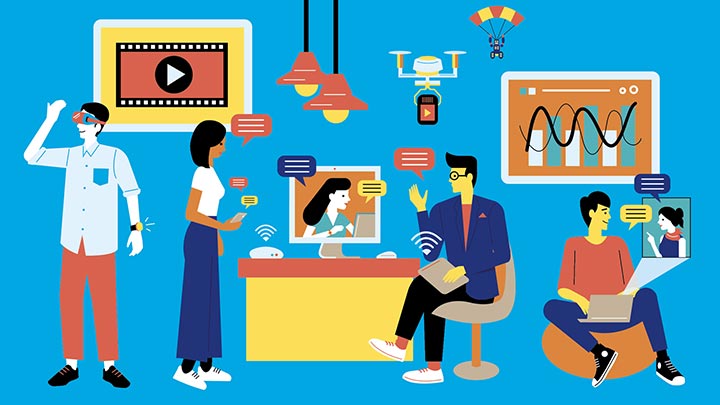Making Change Happen With Technology

The introduction of a simple technology, web chat, increased customer service staff’s productivity by about 30% at the Inland Revenue Authority of Singapore (IRAS).
By using IRAS’ Live Chat to answer queries, staff spent less time fielding calls. A majority (78%) of queries were resolved in just one chat. IRAS staff could easily retrieve common replies (via keyboard shortcuts) and give website links for customers to read more information.
No longer did staff have to struggle to accurately decipher what customers said over the phone, and supervisors could retrieve chat transcripts to monitor service quality. A pilot for the Live Chat service concluded in March 2017, with positive feedback – 89% of customers surveyed found the service useful.
All this was the brainchild of Mr Jerry Liew, an IRAS Assistant Manager who was overseeing a team of frontline helpline officers. He had observed other companies such as SingTel using web chat, and invited vendors to present and share the possibilities of implementing a similar feature for IRAS.
There is a name for change-makers like him within large organisations: intrapreneurs. This describes the people who overcome bureaucratic barriers to solve problems and effect change for the good of their organisation.
The latest phase of Public Sector Transformation (PST) aims to have every public officer adopt this mindset and the skills to effect change.
Change affects all sectors
With trends such as manpower constraints, demographic changes and the latest technologies providing opportunities and disruption, public officers need to find ways to work differentlyl. (Read what Head, Civil Service, Leo Yip has to say about PST.)
A 2017 McKinsey Global Institute study of 46 countries found that, with the technologies currently available, 30% or more of tasks or activities in 60% of all occupations could become automated. This is based on analysis of more than 2,000 work activities across 800 occupations.
While routine and manual work in more predictable environments will be more susceptible to automation, the vast majority of occupations will not be untouched by changes brought about by automation. This means many jobs will have to be redefined as work processes are transformed.
Even the kind of work considered to have a “softer” human touch, like Human Resources, risk being disrupted by technological developments, says Mr Stephen Yee, Assistant Director, Singapore National Employers Federation, at the Fuji Xerox DocuWorld conference in May 2018.

In hiring, for example, many important variables still require human judgement: assessing an applicant’s personality, personal experience, willingness to learn and ability to fit into the team.
But even this complex work of assessment is changing with the use of technologies such as artificial intelligence and video. These technologies are not replacing HR staff, but augmenting their work in certain tasks.
Using video for recruitment
Within the Singapore Public Service, the Public Service Division (PSD)’s Human Capital Services uses video recruitment to augment the selection process. The aim was to make selection more efficient and convenient for candidates and interviewers.
Recruitment usually involves several stages of shortlisting. The video tool streamlines the shortlisting interviews, which is usually done in group interviews. With the tool, the time-consuming process of coordinating candidates and interviewers to attend the same session can be replaced with interviews done virtually.
Behind the scenes of recruitment are numerous manual processes and man-hours to support it. To fill each vacant role in the PSD, Mr Thomas Sim, a Senior Assistant Executive at the PSD (Human Capital Services) used to spend hours on administrative and logistics work, from scheduling interviews to setting up rooms.
Video recruitment has reduced much of that work. Now, he uploads interview questions into the system, where candidates can view, answer and submit their responses at their convenience.
Candidates are invited for a formal interview session in person only when they are shortlisted after the video interview. “This is much more customer-centric,” Mr Sim says. “Candidates no longer have to take leave from work for a face-to-face shortlisting interview.”
All candidates applying for the same position are asked the same set of questions to ensure a fair assessment. Their responses and the interviewees’ videos can then be shared with other hiring managers within the PSD looking to fill similar roles.
How individuals can create change
Adapted from reports by consultancy Deloitte and Portable, a design and technology company, and projects shared by public officers.
- First identify the problem: What is the change you are seeking? Talk to others – they may have faced the same problem or tried similar ways of solving it. Avoid trying to find solutions to an ill-defined problem.
- Be observant. Bring in ideas from outside your agency or the public sector that may be relevant to solving the challenge being faced.
- Put together passionate teams with complementary expertise to answer unmet needs and get things done. Finding the right partners could make the difference in whether your project takes off or gets blocked.
- Find ways around the old way of doing things. This could mean tapping into wider networks and building new connections so you can pitch your ideas to the right person.
How organisations can support change
Part of digital transformation, the SNEF’s Mr Yee adds, is the need to develop a culture of change and trust within organisations. This is crucial to overcome typical challenges such as employee resistance, inertia to change and a lack of expertise or strategy for digitisation within the organisation.
At the PSD, Mr Sim had worried about making mistakes during the video recruitment pilot. “I needed time to get familiarised with the system,” he says, “but I was open to trying out this new initiative as it really improves the recruitment team’s efficiency.”
Mr Christopher Soo, then-Manager, PSD (Human Capital Services), was also apprehensive about the “buy-in” for the video recruitment pilot. “It required us to re-think our internal processes,” Mr Soo says. But he had the support of “champions” such as recruiting directors who saw the benefits and even helped to promote its use across the Public Service.
He adds that it was good to have support from management level for tools that “tested the traditional ways of doing work”.
After sharing their experiences of the pilot with the Public Service human resource community, other agencies such as the People’s Association and SkillsFuture Singapore have also piloted video recruitment.
More ways to continuously learn

To learn on the go any time of the day, public officers can tap e-learning courses by the Civil Service College (CSC), which has partnered with 12 local institutes of higher learning and Udemy for Government, a massive open online course provider. Choose from more than 2,500 courses on topics such as data analytics, productivity and management, with bite-size content including infographics, videos and quizzes. CSC online courses with Coursera are also available.
Creating change requires financial resources and staff being able to make time to brainstorm ideas and solutions.
Mr Liew was able to use his agency’s Divisional Innovation Fund to run the pilot for the Live Chat solution. Setting aside discretionary funds for innovation is another way to encourage staff to try out quick experiments.
He adds: I’ve since realised that innovative change cannot happen just because of one’s ideas or knowledge. Innovative change only happens when we seek to understand and believe in each other, and work towards it.
The main obstacle to overcome is “ourselves”, as Minister for Education Ong Ye Kung said at the Public Service Conference 2017, and “all of our entrenched processes, bureaucracy and a culture of being afraid”.
Celebrate failure – by documenting it
Regulatory sandboxes, hackathons and innovation challenges are all methods that various governments use to provide safe spaces to experiment.
An idea to explore is having a shared repository of experimental projects, documenting both the small successes and failed steps along the way.
Australian design and technology company Portable did a study of more than 100 people in government roles. Documenting the failings is just as essential as celebrating the successes of innovation projects, they found.
Their suggestion is to keep a record of all the steps taken along a project, which could be shared across government agencies. This could be in the form of a blog or a website accessible to public officers looking to learn from previous attempts or related projects.
Putting each project into context promotes a culture of learning, builds knowledge and confidence for other public officers and future collaborators, and prevents repeated missteps.
Beyond this repository, innovators and project leaders should present their findings and learning points in person, Portable suggests.
Talking openly about what worked and what did not will spark more engagement and insight from colleagues and bosses, and create opportunities for making connections and gaining buy-in for future innovation.
- POSTED ON
Sep 5, 2018
- TEXT BY
Tuber
Alvan Yap
- ILLUSTRATION BY
Mushroomhead
-
Deep Dive
Strengthening Singapore’s Food Security









